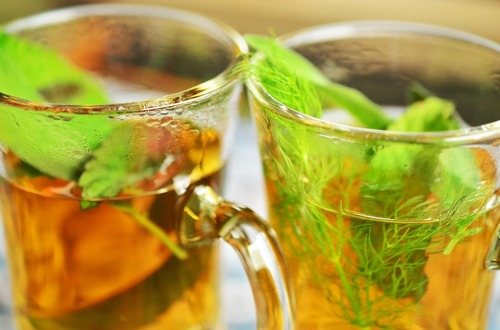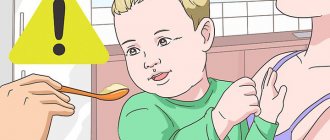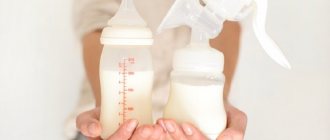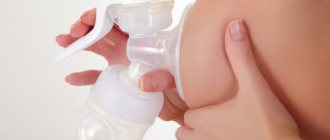Excessive production of breast milk causes a lot of inconvenience to a nursing mother. She is forced to regularly resort to additional pumping to prevent stagnation and further troubles with her breasts.
The babies of such mothers also have a difficult time: it can be difficult for them to suckle due to an overly active flow of milk, feeding becomes nervous and fussy. These difficulties are accompanied by less significant but unnerving moments - unpleasantly overfilled breast pads, excessive milk leakage, more dirty diapers and nappies. But if a mother wants to reduce her breast milk production, she first needs to understand whether she really has too much milk.
When is it necessary to reduce lactation?
The need to slow down the rate of milk production usually occurs in case of hyperlactation. The main symptom of this condition is very rapid breast fullness. For example, the baby ate only half an hour ago, and has not yet expressed readiness to suck again.
And my mother’s breasts are already engorged and are experiencing noticeable discomfort and even pain. If under such conditions a woman does not express at least a little secretion, the risk of swelling, blockage of the ducts, lactostasis and subsequent mastitis (inflammation) increases. Therefore, women often find themselves in a vicious circle: they cannot help but relieve their condition by pumping, and frequent emptying of the breasts leads to even greater milk production.
Excess milk often accompanies the first three months of a baby's life. The mother's body adapts to the child's needs gradually, and by three months the secretion production stabilizes. That is, the breast produces exactly as much nutrition as the baby sucks. Supply equals demand. And at first there is an abundance of milk, because, figuratively speaking, the woman’s body does not understand how many children need to be fed.
When is a diet needed?
If you are breastfeeding, you have probably noticed more than once how your diet and the foods you choose affect the baby’s condition, as well as the quality and quantity of milk. When you are looking for a way to reduce lactation, consider the dependence of the amount of breast milk on your menu.
Sometimes in a mother’s life there are situations when lactation should be reduced only for a certain period of time, for example, an urgent departure. By following a simple diet, you will achieve this goal in about 2-3 weeks. If you later need to increase the amount of breast milk, you can also do this by changing the menu.
There are products that reduce milk production, but they will be harmful to the baby. For example, quite often you can find recommendations for the consumption of smoked meats, canned food, hot herbs and spices. Yes, under their aggressive influence, milk can really leave you, but the baby will develop colic or other digestive problems.
Products - helpers
Then what foods safely reduce lactation? Here's the list:
- black pepper and other spices;
- mint or lingonberry tea;
- decoctions and infusions based on sage;
- folk recipes with parsley;
- a decoction of horsetail in combination with sage;
- infusion of belladonna, white cinquefoil or jasmine leaves.
What to exclude
As you can see, products that reduce lactation are mainly herbs. Unfortunately, there is no food that can have a significant effect on reducing the amount of breast milk. But you can achieve this effect by excluding the following products from your menu:
- walnuts and hazelnuts;
- seeds;
- limiting fermented milk and dairy foods;
- tea with milk;
- carrot juice;
- beer;
- any hot dishes and drinks;
- dairy products;
- limit your fluid intake per day to 1.5 liters;
- also reduce the amount of foods that contain a lot of liquid.
These dietary restrictions should help you reduce your milk supply, but you shouldn’t expect miracles from them - more often than not, a special diet will act as an additional method. However, if you need a temporary reduction in lactation, the above menu changes will be very helpful.
The problem of excess lactation
Most babies whose mothers experience hyperlactation gain weight too quickly. Their natural desire is to suck frequently, and not just for the sake of getting food. But with each attachment, the child receives another portion of nutrition. Therefore, increases can be significantly higher than normal.
The opposite situation also happens: the baby’s weight increases more slowly than is acceptable for an infant. The reason for this may be a lack of milk supply, since the baby finds it difficult to cope with its strong flow. He may nurse frequently but not actually get enough milk. Regurgitation due to swallowing air during feeding can also interfere with weight gain.
Signs
When a mother has a lot of milk, other features may appear in her well-being and the baby’s behavior during breastfeeding. They may or may not accompany this condition, so they cannot be considered reliable evidence of excess milk production. Other possible signs of hyperlactation include the following.
- Constant and abundant leakage of milk. When the baby suckles on one breast, milk actively flows out from the other side. This situation can also happen between feedings. Sometimes mothers have to change several diapers on their chest while the baby is sucking. And during the day, throw away more than one bra pad. However, copious leakage of secretions also occurs in women without hyperlactation.
- Restless behavior of the child at the breast. Babies from very milky mothers often fuss, get nervous and cry during feedings. They take and release the breast, hiccup, spit up and cannot cope with the strong flow of fluid.
- The milk flows out in an active stream. This is a completely normal situation to start feeding. But it happens that the force of the flow does not weaken even after a few minutes.
- Short but frequent applications. Since the abundance of milk does not allow the baby to suckle comfortably, he may ask for the breast too often. In this case, the duration of application may not exceed several minutes. Although, normally, healthy children are able to get enough after five to seven minutes of effective sucking.
- Excessive gas and strange stools. Babies from mothers with hyperlactation often have abnormal stools: foamy, watery, greenish in color.
- Repeated blockages of the ducts, lactostasis and mastitis. Excess secretion and its untimely removal often lead to problems with the mammary gland. However, these consequences also have other reasons (errors in attachment, infectious disease, rare feedings).

Causes
Hyperlactation can be caused by hormonal characteristics of the female body. It can also be encountered by mothers who carefully follow the advice to express “to the last drop” after each feeding. Excess milk also appears when breasts are changed frequently during one feeding. That is, the baby is transferred to the other side before he has completely emptied the first. This happens even if you follow the recommendations to keep the baby at each breast for a certain number of minutes so that he is sure to receive milk from both glands at the same time.
How does it affect the child?
Abundant milk production, it would seem, is not a problem at all. After all, many mothers are struggling to increase its volume. Meanwhile, hyperlactation can seriously worry the baby. Frequent and short sucking with constant breast changes leads to the fact that the baby does not empty the gland completely.
He receives mainly “foremilk”, rich in lactose (milk sugar). It has a very low percentage of fat, so it is less nutritious. Normally, the baby drinks it at the very beginning of feeding. With prolonged sucking, particles of fat are added to it. And the longer the feeding, the more high-calorie milk the baby sucks out.
If the baby is breastfed often, but not for long, and at the same time moves from one breast to the other during one feeding, he gets the “fore milk”. The intestines are filled with an excess amount of lactose with a reduced fat content. This disrupts normal digestion processes and leads to rumbling in the stomach, excessive gas accumulation, and foamy and green stools. Naturally, these problems bother the baby and spoil his mood.
What's the result? Frequent attachments, crying and nervousness of babies at the breast make mothers think that they have little milk. Or it is not nutritious enough to satisfy the child's needs. Although, in reality, there is more nutrition than is needed. Thus, unreasonable supplementary feeding with formula may appear in the baby’s life.
Video on the topic Mama Lara about excess breast milk
The need to reduce lactation levels
Stopping milk production can become a necessary measure in a number of situations and be caused by medical indications. Methods for eliminating hyperlactation are divided into folk and medicinal, based on dieting or physiological effects.
Methods can be aimed at temporarily stopping milk production or reducing its volume.
In what cases may it be necessary to reduce lactation:
- The need for reduction may arise during the postpartum period.
- The use of certain medications to restore the mother's health may require temporary interruption of feeding.
- Forced, temporary separation from the baby may cause the need to reduce the intensity of lactation.
- The introduction of a new diet after six months reduces the need for breast milk, the amount of production of which will need to be adjusted.
We recommend reading: Milk crisis during breastfeeding
To significantly reduce lactation, it is necessary to resort to a set of measures.
Bad advice and myths
In attempts to “tame” lactation, nursing mothers often make the same type of mistakes. Because of this, they not only cannot cope with excess milk, but also aggravate the situation.
What a mother with hyperlactation should not do:
- constantly use a breast pump;
- express after each feeding;
- try to express your breasts “to the bottom”;
- often shift the baby from one side to the other during one feeding;
- change breasts every feeding;
- ignore the feeling of painful fullness in the chest;
- crush, crush, traumatically strain the gland;
- uncontrollably take herbs and medications to suppress lactation;
- tightening your breasts and wearing tight underwear.

Pulling - why doctors are against it
The experienced older generation loves to give various advice to the young mother with or without reason. And if you share that you want to reduce your milk supply, a caring grandmother will confidently tell you that breast tightening is the best way. This recommendation can be found quite often on the Internet.
So, inspired by the simplicity of this method, mommy enthusiastically sets out to find an elastic bandage or scarf. And he makes a big mistake! You can ask any modern doctor about the wisdom of this method - he will probably quickly convince you.
The fact is that by tightening your chest, you create all the conditions for poor circulation. And this entails such serious consequences as mastitis or lactostasis. This is understandable: tight tugs directly affect the formation of milk stagnation.
Sometimes this method can be effective and safe, but this is only if you have already noticed a decrease in the amount of breast milk. We still advise you not to take risks, but to resort to more loyal means, for example, choosing products that help reduce lactation.
Decreased milk production when complementary foods are introduced
Nursing mothers with excessive milk secretion make a lot of efforts to establish lactation in a comfortable manner. Many of them then strive to feed their babies for as long as possible. Therefore, the slightest changes in breastfeeding rhythms cause concern and anxiety. For example, there is an opinion that when you introduce complementary foods, the amount of milk decreases. In fact, complementary feeding products complement, rather than replace, mother's milk.
Breastfeeding remains approximately the same daily amount (10-12 times), but they are distributed differently throughout the day. An older baby breastfeeds mainly around dreams and at night. During the day he eats regular food. Therefore, if you maintain a sufficient number of latch, milk production will not change even during this period.
But when a child is weaned, milk secretion actually decreases. With the physiological completion of lactation, this occurs smoothly and painlessly. But here, too, the need to periodically express is not excluded. When the number of feedings is reduced, the breast does not immediately adjust to the new regime. From time to time she needs help - to pump up the discomfort until she gets relief. This applies not only to mothers with excess milk production, but also to mothers with normal secretion production.
Related video Nina Zaichenko talks about the problem of hyperlactation
Hyperlactation leaves mothers wondering how to reduce their breast milk supply. There are simple and effective ways to do this that you just need to try in practice. There is another alternative: not to fight the abundant “rivers of milk”, but to use them for the benefit of other children. Some mothers choose to become breast milk donors. They donate the surplus to a special milk bank. And from there he is taken by women who, for various reasons, are not able to feed their children themselves. So addressing hyperlactation can be a wonderful way to help other babies stay healthy.
About the reasons for stopping breastfeeding
The mother must inform her doctor about her desire to stop lactation. This is followed by an analysis of the cause and the development of an action plan. The measures taken to stop lactation largely depend on the motivation for such a responsible decision. Sometimes it is impossible to do without medication. But there are cases when folk remedies in combination with a special diet consisting of foods that reduce the ability to lactation can help reduce milk production.
So, among the main reasons for stopping lactation are the following:
- the most common reason for such a decision is health problems of the mother or baby;
- sometimes it is necessary to reduce the amount of breast milk only for a while, this happens due to an urgent trip or the mother’s departure;
- sometimes a woman complains of an excess amount of milk, which is too much for the baby, and if in this case the lactation is not reduced, there is a risk of mastitis or lactose deficiency;
- the age after 2 years is considered optimal for weaning - and if it has arrived, the mother almost always faces the need to stop milk production;
- There are many advantages to maternity leave, but often the mother has to go to work at the age of 2-3 years and stop lactation;
- a new pregnancy may also be the cause;
- sometimes a mother just gets tired of breastfeeding and wants to stop it;
- Taking some medications is incompatible with feeding milk, so its production must be stopped.
When deciding to stop lactation, a woman must carefully weigh the pros and cons. First of all, you should think about whether there is such a good reason to deprive your baby of breast milk. If the answer is firmly positive, then you should move on to active measures and you can start by choosing products that reduce lactation.

When to reduce lactation
The need to partially reduce breast milk lactation arises for various reasons. In most cases, young mothers want to do this only for a while, so that they can then continue to feed the child. Here are some of them:
See also:
Using camphor oil to stop lactationCessation of lactation
How does a woman’s breast milk burn out? Termination of lactation
Herb sage to stop lactationCessation of lactation
- The first days after childbirth, when a lot of milk is produced, but the baby still eats little.
- An illness of the mother, which requires temporary weaning of the child from the breast.
- Mom's departure from home for a few days.
As a child grows up, he begins to eat many complementary foods. After six months, the nutritious foods contained in milk are no longer sufficient. During this period, the mother also needs to reduce the amount of milk in the breast so that there is no stagnation. This often occurs naturally, but some breastfeeding women may experience problems. There are situations when milk production must be reduced sharply, for example, if the mother gets sick.
A few more tips
Choosing a diet based on products that reduce lactation can be supplemented with several more effective actions:
- if possible, reduce the amount of milk and wean the baby from the breast during the lactation crisis;
- during this period it is better to wear a thick cotton bra with no underwire;
- Closed clothing without cutouts on the chest would be preferable;
- do not deprive your baby of a pacifier or bottle - they will comfort him at the time of weaning;
- maintain a calm and confident attitude - then the little one will feel that there is nothing terrible in the changes taking place;
- Consult your doctor to find the best way to control your milk supply;
- It’s unlikely that the baby will immediately “receive your idea with a bang” - but you shouldn’t give up and give up slack: if you go against your script, you’ll only make weaning worse.
And finally, the most important thing: always stay in a good mood, regardless of whether you are consuming products to reduce lactation. If you think and act positively, then even such a difficult stage as weaning and reducing lactation will pass easily and naturally!
How to reduce the amount of milk
Let's start with the fact that, generally speaking, a lot of milk is good. The child will be well-fed and healthy, because mother’s milk is the best and healthiest food for young children. But sometimes it happens that there is not just a lot of milk, but a lot. And for a woman, an excess of milk is little better than a lack of it:
- Overfilled chest aches and hurts
- Overfilled breasts are at high risk of lactostasis
- It is more difficult for a baby to latch properly on an overfilled breast, so feeding can be painful for the mother.
- Milk flows from an overfilled breast in dense streams, the baby gags, swallows air, and then burps or suffers from tummy pain.
- Milk from an overfilled breast leaks, wets clothes and causes irritation (both the skin and the entire mother ;))
- Breasts begin to stretch from excess milk (yes, those terrible stretch marks!)
How can you tell if there is too much milk?
- The breast is constantly overflowing with milk, hot and resembles a balloon
- Overfilled breasts hurt, pain radiates to the armpits
- Feeding does not provide significant relief
- Milk constantly leaks from the breast drop by drop
- When trying to express, milk either does not come out or comes out of the breast in tight streams.
Why is there too much milk?
Mostly, problems begin for young mothers in the maternity hospital or in the first days after discharge - milk comes in. The causes of hyperlactation (excess milk) can be different. This is both heredity and the efforts of the woman herself, who is worried that there will not be enough milk - in the first days after childbirth there is still no milk, but there is a small amount of colostrum, and the baby intensively suckles at the breast. In addition, too much milk occurs when there is a hormonal imbalance (more often during infertility treatment, taking birth control pills, or with pathologies of the thyroid gland, ovaries or pituitary gland).
Basic mistakes
First of all, let’s list the most logical at first glance, but least effective
(or even aggravate the problem!) measures taken by inexperienced mothers who have too much milk:
- Limit drinking
- if the body has already become “stuck” and the brain receives a signal to “produce a lot of milk”, restricting fluids will not improve the matter - there will be no less milk, but the body can become dehydrated. - Reducing lactation with hormonal drugs
, especially without the advice of a specialist, can easily overdo it and stop milk production for good, ruin your figure, and just get addicted to hormones. Such a measure is possible, but only after passing the appropriate tests, identifying violations and consulting with a specialist. - Express all the milk
- the more milk we express, the more milk comes next time. - Tightening the breasts
- such a measure will not particularly affect the amount of milk, but it can easily provoke lactostasis.
What to do if you have a lot of milk?
In most cases, it is quite possible to regulate lactation on your own without turning to specialists. If you act wisely, you will not be in danger of losing milk, but you will learn to cope with the “rivers of milk” and will be able to safely feed without experiencing discomfort. Here they are, smart actions if you have a lot of milk
:
- Feed the baby with one breast at a time - if it is usually recommended to give first one breast and then the other at one feeding, then if you have a lot of milk, the baby will be fully fed from one breast.
- Monitor the baby's latch - if the latch is incorrect, the baby does not get to the hindmilk, which is fattier, but the foremilk, which is sweet, is quickly absorbed, and the baby asks to eat again, stimulating additional milk production.
- If the baby cannot latch onto an overfilled breast, or latch onto it but is choking, it is worth expressing a little milk before starting feeding to make the task easier for the baby.
- If the baby is choking on milk, swallowing air and spitting up profusely, feed him in a vertical or semi-vertical position. The trick is to ensure that the baby's head is higher than his stomach, then the air comes out on its own without causing any discomfort to the baby, and the milk is better absorbed. You can even feed a newborn in an upright position, either in the usual “cradle” position, with your legs lowered, or in a self-attachment position, when you recline on your back, the baby lies on your stomach and in this position takes the breast.
- If milk is leaking from the second breast, you can either close the nipple with your finger for 1-2 minutes (after which the milk will stop flowing on its own), or place a glass under the flow of milk, or place an absorbent pad in your bra.
- If you do not feel relief after feeding, it is quite possible to express some milk until you feel relief.
- Pumping until you feel relief is also a measure to prevent lactostasis - your task is to develop the breasts so that if a lot of milk comes in, it does not burst the breasts, but leaks (you must admit, it’s easier to put a special absorbent pad for milk in your bra than to strain lactostasis).
- To alleviate the general condition, you can put a cabbage leaf or a cool compress on your chest.
- Avoid hot drinks – hot drinks stimulate hot flashes. You need to drink according to thirst, even if you have a lot of milk, but drinks should be at room temperature, and it is advisable to drink no more than 2 liters per day (average daily fluid intake).
- Gradually try to reduce pumping to nothing.
If you see that the situation is getting out of control, you should consult a professional lactation consultant.










